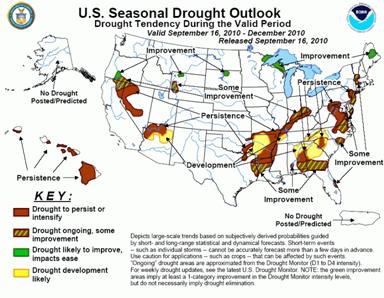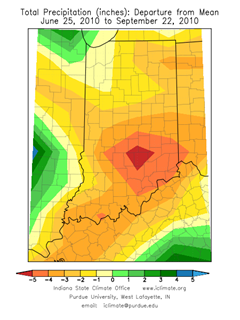Many turf professionals in central and southern Indiana are trying to figure out how best to cope with the current drought because it is affecting their normal 1) fall seeding, 2) fertilization, 3) herbicide applications and 4) cultivation. Below are some strategies on how to cope with the current situation.
The maps below show illustrate the lack of rainfall in central and southern Indiana over the past 90 days (since the heavy spring rains).


Drought Facts
-
Though turfgrasses perform best with enough regular irrigation during the summer to keep them green and growing, they are very capable of surviving without rain or irrigation.
-
Turfgrasses perform much better under slightly dry conditions than under wet or saturated conditions.
-
Turfgrass dormancy (brown turf) is a survival mechanisms allowing survival up to up to 5-8 weeks without irrigation/precipitation without significant thinning upon recovery from dormancy. This would be under ideal conditions of no regular traffic, good soil, moderate temperatures, no shade, minimum thatch, etc. However, survival is affected by species, age, shade, fertilization, mowing, traffic, heat, etc., etc.; so optimum survival may not occur on your particular area.
Managing turf during drought
-
When possible stay off the turf! Limit traffic (including mowing) to minimize crushing of the turfgrass leaves and crowns.
-
Water once every 4 weeks with ¼ to ½ inch of water to keep turf plant crowns hydrated. This amount of water should not green up the turf, but it will increase its long-term survival.
-
Turf should recover in 1-2 weeks after significant rainfall returns.
Should I fertilize right now?
-
There are two strategies that could be used. First, professionals might consider applying 0.75 lbs N/1000 ft2 with a 30-50% slow release N source. This should help to speed recovery when rains resume but minimize any leaf burn with a lower nitrogen rate and some slow-release nitrogen. Keep in mind that drought stressed plants will not take up nitrogen, and so a response to nitrogen fertilization will only occur after a rainfall occurs and the plant has a chance to take-up the nutrient. A second strategy would be to wait to fertilize until after the turf greens-up after the next rainfall.
-
Aggressive fertilization may be needed after the rains return to help the turf recovery before winter.
-
Normally we would recommend fertilizing 1.0 lb N/1000 ft2 in September and November in lawns. This year it may be necessary to fertilize in October and November to encourage recovery from drought prior to winter. Weak turf that enters winter dormancy will emerge in the spring weak and be more susceptible to weed invasion next year.
-
Although aggressive fall fertilization is needed to help our turf recover, it could also promote some increased snow mold damage in turf next spring.
Should I apply a herbicide right now?
-
Herbicides are ineffective on drought-stressed weeds and can be damaging on drought-stressed turf.
-
Avoid the temptation to apply herbicides even though weedy species may become more obvious in a dormant (brown) lawn.
-
It is better to hold off on applying fall broadleaf herbicides until rain returns and the turf and weeds being growing again.
-
Broadleaf herbicides can be applied in Indiana until early November and still provide effective control.
-
Read the herbicide label carefully if the area you want to treat has recently been seeded. Most herbicides require that newly seeded turf be mown 1-2 times prior to a herbicide application.
Should I seed right now?
-
It is not too late to seed, but it is past the optimum window due to the fact that we will start experiencing cooler weather soon which will slow down the growth of turf and thus take longer for seeded areas to establish and fill-in.
-
Thin areas with 4 inch or smaller gaps in turf can be overcome with aggressive fall fertilization. Lawns with larger gaps in turf should be reseeded.
-
Droughty, unirrigated areas can be reseeded now and they will establish once consistent rains return. Alternatively, droughty areas can be reseeded now and irrigated at least twice daily by homeowners.
-
Consider using a starter fertilizer in reseeded areas to help with establishment.
-
If a herbicide has been applied to these areas within the past month it could hinder seedling establishment. Additionally, most herbicides require that newly seeded turf be mown 1-2 times prior to a herbicide application. Please read the specific herbicide label for the product you are considering using to learn more about seeding restrictions.
-
Will new seedling be more likely to winterkill? Maybe. Tall fescue seeded late (past mid-October) will not be very developed and will be more likely to winterkill, especially in Northern Indiana. Kentucky bluegrass seedlings typically will not suffer any winter injury.
-
Below are pictures of a spring seeding that help to illustrate this point. Both tall fescue and Kentucky bluegrass were seeded during a warm March spring and had germinated before the significant frosts in early April. The images below show tall fescue seedlings (A left; B) that were damaged by this year’s frost while the Kentucky bluegrass seedlings (A right; C) in adjacent plots were not damaged. Some of these tall fescue seedlings recovered from the damage, but recovery from damage was slow. Therefore, be careful when seeding tall fescue late in the year or too early in the spring for risk of frost or freeze injury.

Can I aerify lawns right now?
-
Core aerification will provide many benefits to turf including decreased soil compaction and thatch and increased soil aeration and water infiltration.
-
Despite the benefits of aeration, it is only effective when the tines can penetrate the soil. Attempts to aerate dry soil will be ineffective.
-
One good week of rainfall may be needed before soils will be moist enough to aerify.
-
Aerification can be safely done to Indiana lawns until later October.
-
Athletic fields can be aerified into November as it is more crucial to relive compaction in these soils due to their higher need for compaction relief.